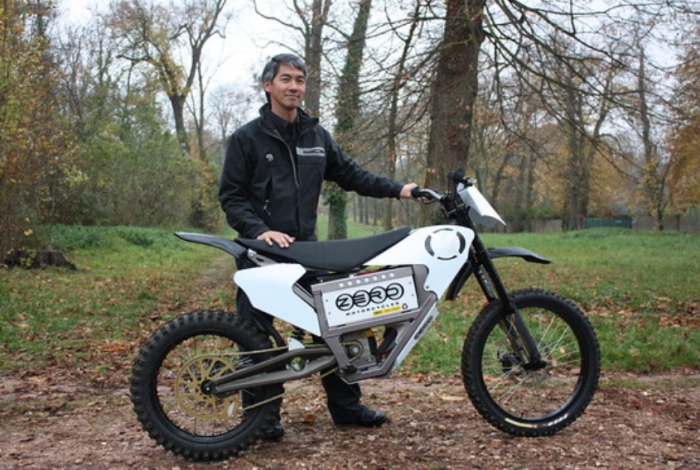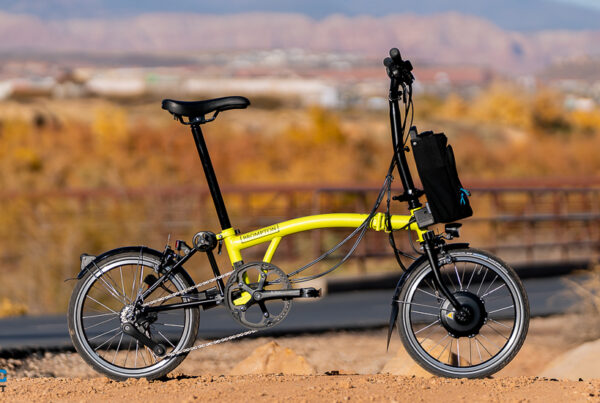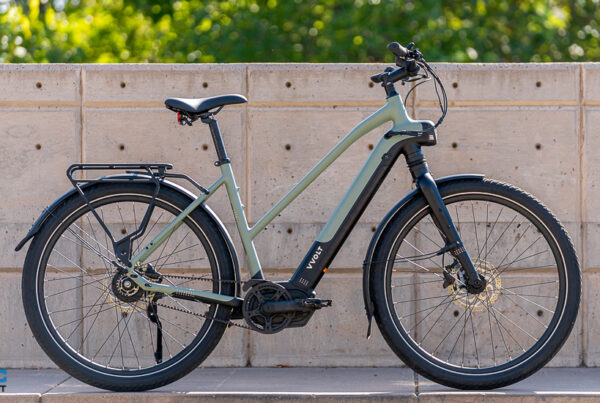The story begins with one guy, Neal Saiki (SY-kee). He is an engineer who worked for NASA for a while, which shows that he is a pretty smart guy, and also why he was always up to date on new tech developments.
Before starting Zero, he worked at Santa Cruz mountain bicycles, and it seems he has always been developing new products (either full-time or on the side). The early articles about him seem to indicate that he was most interested in the new battery developments that were blossoming just before he started Zero in 2006. In fact, he continues to work to this day with an electric bicycle company he and his wife Lisa formed called “NTS Works“. The interesting part of the NTS ebike is the innovative battery case, which can easily be re-filled with new cells by the owner when the original pack is worn out.
This very much endeared me to Neal, because…when a manufacturer produces a proprietary interface, you can only buy the replacement batteries from their catalog. But…Neal’s battery case design allows the customer to source 18650-format cylindrical-cells from anyone (found in laptops and cordless tools), and easily swap them out in their own garage.
Also, when the cells are worn enough that the owner is only getting about 80% of the range compared to when they were new? The old cells still have 80% of their capacity. There is a growing movement of home-tinkerers who are using near-free “used” lithium cells to make a power back-up battery pack for their home, so…this is not as kooky as it may at first sound. Now…let’s get back to Zero motorcycles…
_____________________________________________
I know this article is about Zero, but nothing happens in a vacuum, and it’s useful to remember that the Tesla car company was started in 2003, so…by 2006, Tesla had quite a bit of buzz about how the new batteries that were then available were actually making EV’s viable. Tesla had been showing their Roadster prototypes to investors, and it was clear that they were aimed at competing with FUN cars, rather than only “being green” (like the failed GM EV1).

Neal is a brilliant guy, so it wasn’t a big leap for him to realize that motorcycles were a much smaller investment risk, compared to an electric car. If investors were excited in 2006 about electric vehicles that were fun and performed well, then…the time was ripe for someone to start a company that could show the world about everything that an electric motorcycle could be.
He was right, of course. The booming US economy of 2006-07 meant that it was the best possible time for investment and risk-taking on Wall Street. However…apparently nobody could see the devastation of 2008 that was looming just around the corner. Opportunity is a two-edged sword that cuts both ways. By accepting venture capital to fuel growth, Zero now had the money to produce a high-quality production prototype, and scale-up some type of manufacturing facility. However…by accepting that money? he now had to answer to a corporate board of directors, and…it was just at a time when the economy was about to take a huge dump…
The stakes were high, and Zero appeared to be the first company that would produce a viable mass-produced electric motorcycle. Anyone involved was swimming in “buzz”, and as far as anyone knew, Zero was going to be the next Tesla. However, the severe recession of 2008 let the air out of the bubble and even established companies were suddenly struggling. During this difficult time, Zero managed to produce its first production model in 2010, using the Agni-Lynch motor and the very safe LiFePO4-chemistry cylindrical-cells from Molicel.
_____________________________________________
in February of 2011, the Board of Directors appointed Gene Banman as the new CEO. Neal Saiki stayed on as Chief Technical Officer / CTO. Remember when I mentioned some turmoil? Just a few *months* after Banman became CEO, he stepped down (but stayed on as a member of the BoD). One encouraging note is that at the same time, Mark Blackwell joined the BoD, and he had previously been VP of motorcycles at the global Polaris company. Polaris is best known for its snowmobiles and “Indian” motorcycles.
For a while, the leadership gaps in Zero’s history were managed by their Chief Operations Officer / COO, Karl Wharton.
In July of 2012 (amid various start-up production and design glitches, plus a few recalls), Richard Walker became the CEO. The entirely revamped 2013 lineup was already being designed, so…it looks like he took over just as Zero had found its stride. Walker did a good job, and it appears he held onto the leadership of Zero until July of 2016 when he was replaced by Sam Paschel. Walker is now part of a venture capital investment group for new tech companies.
_____________________________________________
2013, The Breakout Year
Every year at Zero, the product was improving in a variety of ways. However, there was a distinct change in the 2013 models. The 2010 models had used the Agni axial-flux brushed motor. By using brushes, the controller could be more simple, along with being less expensive. However, in spite of the efforts to make choices that enhanced reliability and kept the price affordable, there were enough problems with design issues and quality…Zero needed to consider big changes.
Potential customers seemed to really like Zero motorcycles, but…customers wanted more power and range, and Zero needed to fix all of the reliability issues, or…recalls would bankrupt them. The system voltage was doubled from 14 cells in series (14S / 52V), to…28S / 104V. And. In 2013, the motor was now a radial-flux inrunner brushless PMAC / IPM design.
The higher voltage and new motor provided a BIG bump in power, and the new battery using Farasis flat foil cells provided more range and a much longer pack life. Although the early QC issues were painful to their reputation (and investor confidence), it forced Zero to improve quality much more than they might have done otherwise.
In 2015, Zero upgraded their products with Showa suspension parts, Bosch anti-lock brakes (ABS), and an optional battery range of 186 miles…this shows that the large global suppliers of motorcycle parts now wanted to be associated with Zero, rather than being afraid of taking that risk with them.
_____________________________________________
Sam Paschel, CEO since 2017
I am very encouraged about Zero motorcycles today for several reasons. Sam Paschel has been there for a couple of years, and it appears he is likely to be staying on for the near future. That alone retains the stability that they achieved under Richard Walker at a very important crossroads in Zero’s growth. Plus, there are several things I really like about Paschel…
In the business world, many power brokers truly believe that a good manager can guide a company to growth and diversification, no matter what the product is. Case in point…when Steve Jobs stepped down from Apple Computers to start a different company in 1983, he persuaded the head of Pepsi Cola (John Sculley) to take over Apple. High-end computers are not soda, and…it did not go well.
How does this relate to Sam? He is an engineer (Swarthmore), and…he has been riding motorcycles ever since his dad had gotten him a Suzuki RM80 (and didn’t tell his mom), and…that happened when he was 8 years old. He spent several years after college trying to get a used Honda CB550 to run, and also to stop shedding parts all over the highway.
This executive rides.

I also found a couple of behind-the-scenes guys who played a part in the Zero motorcycle evolution…Abe Ashkenazi, and also Luke Workman.
Abe worked at Buell Motorcycles from 1995-2009, so…in in spite of his recent success being in charge of the tech used in Zero motorcycles, he is a motorcycle guy from way back. The fact that he has been at Zero from 2010 to the present day shows that he is one of the people who has seen the entire transformation of Zero from its beginnings into the successful company that we see today. The steady series of promotions on his record tells me that he played a crucial part in the successes of this company during that time.

Next up is Luke Workman. Luke is a “true believer” in the electric vehicle movement, and his personality is an infectiously positive attitude that absolutely radiates everywhere that he goes. Luke was an old hand at wrenching and riding superbikes, and also turbo Honda cars. Somewhere along the line, he became fascinated by electric vehicles, and…Luke isn’t the kind of guy to do anything “halfway”…he dives in with both feet.
Luke is listed as Zero’s Sr. Engineer Battery Specialist from 2010 to 2016. He is currently the senior tech officer at Redivivus (click here).
_____________________________________________
A timeline of Zero motorcycle tech, starting in 2006
Neal Saiki started a company in 2006 called Electricross, and his first product was an electric dirt bike, which I think was a great decision. It was important (at the time) to quickly find out the performance data that he needed in order to make important decisions about the design and also parts supply, and a dirt bike was the fastest way to do that, since it didn’t need to meet Department Of Transportation / DOT street rules, like having lights and turn signals.
Motocross Action Magazine wrote about the “Electricross Drift” in September of 2006, and the first prototype used four lead-acid batteries in-series for a nominal 48V. When they went into production, they immediately provided an optional pack made from lithium-Ion cells, which has a more stable voltage throughout its full-to-empty range, and also provided more miles of riding. I don’t have any information about the Lithium cells they used from 2006-2008.
The entire dirt bike weighed roughly 140-lbs, and the rolling chassis with no battery was 80-lbs. The base-model retail price was $5500. The stock top-speed on smooth roads was 44-MPH, but that could be changed by simply swapping a sprocket, if you wanted better hill-climbing, and didn’t mind a lower top-speed.

In 2007, the Electricross company was renamed “Zero”, for Zero emissions. The name change was needed because they decided that…the overflowing response from customers, magazines, and potential investors had persuaded them that they needed to also make a street version, and they wanted a new name that was less motocross-specific. The pic below is the only one I could find of the 2006 shop, from 3111 Scotts Valley Drive, in the city of Scotts Valley near Santa Cruz, on the central California coast.

The motor was an existing brushed motor in the axial-flux configuration called the Agni, which was designed by Cedric Lynch in the UK. By using a brushed motor, the controller could be fairly simple and affordable. Here is a video of adjusting the timing of the brushes, which also shows the internal configuration. The two side-plates hold stationary magnets, and the central armature spins, which hopefully helps to shed coil-heat to the air.
Here is a video from Jozztek which shows the disassembly and internal configuration of the Agni-R (The R stands for reinforced, so that it can withstand higher RPMs). From the beginning up until the major changes in the 2013 model year, Zero used axial-flux motors. An axial-flux is like plates that are spinning side-by-side, rather than a radial configuration. A radial-flux motor is more like a cup spinning inside another cup.
Zero did not begin shipping the Zero-S “Street” model is significant numbers until 2010. So the tenuous 2006-2008 period was focused on the off-road and “dual sport” models.
_____________________________________________
Zero during 2009-2011
It’s sometimes hard to find information and pics of an older model that is no longer in production, but I stumbled across an unusually good write-up on a 2010 Zero DS (Dual Sport). 2010 is also the year that significant numbers of the Zero-S “Street” version began shipping.
The brushed controller for the 2009-2011 Zeros was the Alltrax AXE4855, and the name indicates that this model has a nominal rating of 48V (it will accept voltages up to 60V), and can provide temporary peaks of up to 550 amps (48V X 550A = 26 kW). The controller was later upgraded to the AXE7245, rated for 72V and 450A = 32 kW (25% more total power, but slightly cooler due to fewer amps).

The 2009 battery was made from cylindrical cells from Emoli / Molicell in the 26700 format (26mm in diameter, 70mm in length), and the pack had twelve cells in series (12S).
_____________________________________________
The world is a better place because of the modern Zero electric motorcycle company, so we are fortunate that these early versions were “good enough” to allow the company to survive. The performance was “as good as could be expected”, but to be honest, there wasn’t a lot of competition during this era. The 44V battery packs that Zero used were reasonable in view of the batteries that were available at that time. However, they do not compare to the exceptional performance of the modern versions. [note, this is 2018, and I recommend that any Zero battery pack from 2011 or earlier should be immediately retired]
If you know of anyone who has one of these early versions, the Agni motor and Alltrax controller are worth keeping if you only task it with 10-HP / 7.5-kW jobs. The battery is another story. Once it is too worn to continue using, Zero does not make any new legacy battery packs replace them. There is some good news though…you might be able to replace a worn 2009-11 Zero battery with salvaged Nissan Leaf cells. Thoroughly research this before attempting it.
Sooner or later, all EVs (like the Nissan Leaf) will have a few examples become involved in a wreck. If the battery pack is in good shape and has only a few miles on it…there has definitely been a market developing for lithium cells of all types. These Nissan Leaf modules contain 58-Ah, and are capable of 240A continuous, and double that as a temporary peak. Replacing a 2009-2011 battery pack with modern Nissan Leaf cells. Each Nissan Leaf module has two cells in series (2S), so a 7-module array is a total of 14S, for roughly a nominal 52V
_____________________________________________
Big changes in 2012
The model year 2012 saw some big changes, and they were significant improvements. The 2012 cells were flat pouch cells made by Energy Innovations Group (EIG) from South Korea and were configured as an 18S pack, which had a nominal voltage of roughly 65V (this is the only year that this voltage was used). From this point forward, Zero has used flat pouch cells. The chemistry was Lithium “Nickel Cobalt Manganese” / NCM. The EIG corporation calls these their 20-Ah “C020” cells. Packs could be made from paralleled modules in 1P / 2P / or 3P, for capacities of 20, 40, and 60 Amp-hours.
However, there is a warranty recall in-place for the 2012 packs, concerning some of the insulation wearing away from vibration. If you have one of these, please contact your closest Zero dealer to have this fixed.

This was also the year for big changes in the motor. The Agni is very efficient and also fairly affordable to manufacture, but hot rodders have stated that it is near its “long term” reliability limits at around 10-HP, and running it at higher power levels reduced its reliability and life-cycle. Customers wanted more power, and the Agni was only an efficient 10-HP scooter-motor. (it could put out 20-HP, but it simply couldn’t last very long when doing that)
The 2006-2011 Agni axial-flux brushed motor, shown above in a 2010 Zero DS. The brushes are on the left side, and the flex-hose is blowing air onto them to clear dust from brush-wear and then blow air through the motor case for cooling the armature. Brushes are a form of rubbing electrical contact that physically touch as they slide from one contact to another. In order to significantly raise the power, the decision was made that Zero’s next motor was going to be brushless.

The Motenergy ME0913 brushless motor has two stators, and one rotor. The new motor for 2011 was based on the Motenergy ME0913 motor but was made to the exact specifications provided by the Zero Motorcycle engineering team. There were significant design changes and improvements required by Zero to make a motor that met all their requirements.
When Zero had specified that the new motor must be brushless, it required a more sophisticated controller than the brushed Agni, and a robust unit from Sevcon was selected. This turned out to be a good choice, and Zero’s relationship with Sevcon continues to this day.
A 3-phase motor with a single stator typically has three fat cables mounted to it, but…as you can see in the pic below, this model is identified by the fact that the three electrical mounting posts are split into six cables that are routed to both sides of the motor. This version uses two of the 3-phase stators and a single central permanent-magnet rotor.

Motenergy’s previous name had been “Mars” electric motors, and they are a well-regarded engineering firm, which can provide motor solutions that meet unusual specifications. By having two stators and a central rotor, the hottest parts of this model are placed at the outer sides, where air-cooling can be the most effective when mounted on a motorcycle as an application.
_____________________________________________
The new ME0913 motor from Motenergy is still an axial configuration, but it is a brushless design, which helps with several issues. Temporary burst power can be increased without producing a lot of the conductive arc-dust from the brushes that had occasionally caused issues in the Agni. Also, It’s possible to water-proof a ‘brushed’ motor, but by using a brushless style, you can easily have a robust water-proofing along with also having the dramatically improved air-cooling.
Another difference is that the configuration of the Agni had a central spinning armature, which worked with fixed permanent magnets mounted inside the side-plates. The Motenergy has a single central magnetic-rotor, and two stators, with one on each side. The temporary-burst power of a motor is created by increasing the amps to the stators, which causes a lot of heat. By having the stators located on the outer sides of the motor, it was easier to air-cool them in a more effective manner.
The Agni remains a respected motor for modest power applications (due to low cost, ease of manufacture, and high efficiency), but a major difference between the Agni and the Motenergy is that even though armatures and stators have many similarities, the electromagnetic fields that can be turned on and off will only extend outwards a certain distance. I point that out so that I can say this; to dramatically increase the amps that the motor can use, you must dramatically increase the copper mass. If we simply make the Agni armature fatter (to add more copper) the armatures’ magnetic fields would not be more effective. The Agni only has one armature (in effect, a single spinning “stator”) coupled with two magnet-array plates. The Motenergy uses a single magnetic rotor, with two stators. It has double the copper mass, if not more.
All of these changes result in a motor that is only slightly larger, and yet it can survive a temporary burst of 400A. When using the nominal 65V of their new battery pack (18S), 400A would result in a burst capability of 27-kW / 36-HP for acceleration (although the 2012 battery packs could not actually provide 400A).
Side note: I was curious about the naming system at Motenergy, and John [the owner] told me that the “09” means that this model was designed in 2009, and the “13” meant that it was the thirteenth model-variation they had designed that year.
This was the year that the batteries at Zero took a great leap forward. They use flat pouch cells from Farasis Energy, They raised the voltage to 28S / 102V. Zero designed the new totally enclosed radial flux motor in-house for the 2013 model year, and they chose Motenergy as the supplier for their new design.
From this era forward, each flat pouch cell increased in capacity over time. Starting with 25-Ah, then 27, and today finally achieving 29-Ah’s each. They started with a 4C continuous current rate (100A from a 25-Ah cell) and ended up today with 29-Ah cells that can peak at 10C (290A). This means the 2P packs have 58-Ah’s and are capable of a 580A temporary burst.
A polymer-embedded 14S module made from flat Farasis cells (pulled from a wrecked Zero motorcycle). The polymer fill makes this block unrepairable if it ever has an issue, and doing this was only possible by producing a pack that is more reliable than any other on the market. The potting also provides extreme vibration and shock resistance, plus a level of waterproofing that is exceptional. The module is shown still worked.
Farasis Energy Inc has its design headquarters located in Hayward California (in the southern San Francisco Bay), with a manufacturing facility in Guangzhou, China (near Hong Kong). Their CEO Yu Wang has led the company to a recent financing expansion that exceeded $1 billion USD (with a “B”), and I’m certain the success of their Zero battery cell technology has played a major part.
Farasis recently opened a new office in Stuttgart Germany, in preparation for building a new advanced battery pack factory. The Zero battery pack design team was headed-up by CTO Keith Kepler. Other engineers involved in the Farasis cell success are Jackson Edwards (“Farfle”), Chase Nachtmann, and Zero battery specialist Luke Workman (“Live For Physics”).
_____________________________________________
2017, The Motor Gets An Upgrade to IPM
The new 2013 radial motors from Motenergy worked great, but there was some room for improvement. The permanent magnets found in these types of motors are a solid chunk of metal, which differs from the laminations, which are a stack of many thin silicon-steel plates. Whenever a solid chunk of metal passes rapidly through a magnetic field, it can suffer from eddy-currents, which results in extra heat. The new radial 2013 Zero motor had surface-mount magnets, and even though it performed very well…the 2017 model was upgraded to a configuration that places the magnets slightly farther away from the surface of the rotor laminations, which allows the magnets in the rotor to run cooler. This is called an “Interior Permanent Magnet” / IPM style.
When you put a permanent magnet next to steel laminations, the steel laminations become magnetized up to a small amount of depth. This means that the magnets can be moved a little farther away from the air-gap between the stator and the rotor, without lowering their magnetic effect on the motor. Doing this reduces the eddy-current heat in the magnets. Permanent magnets can be partially de-magnetized by accident if they get too hot, so magnet-heat is one of the limiting factors in the number of amps and power that a motor like this can survive.

Radial in-runners attach the coils in the stator to the stationary aluminum shell, which does a pretty good job of passively shedding the stator-heat to the ambient air. The engineers at Zero are familiar with all of the known liquid-cooling systems for motors, so this was a conscious choice rather than a compromise. The two biggest reasons I can think of for choosing passive air-cooling is the simplicity, which has a clear element of reliability, and secondly to also to keep the costs affordable. There are 12 poles on the stator (3-phase), and 10 poles on the rotor
_____________________________________________
Here’s part of a discussion that I found interesting from a technical forum
“I just noticed that the Zero S and SR have the same motor Z-Force 75-7 and that motor is rated 40-kW in the Zero-S but 50-kW in the Zero-SR. Previously, I said “Zero-S power is limited by the motor, not the controller or pack” but that’s not correct. Actually, Zero-S power is limited by the controller, not the motor or pack.
Here’s my reasoning: The same motor model–the Z-Force 75-7–appears in the Zero S and SR. In the Zero SR, the 75-7 motor is rated 50-kW, so we know the motor can handle 50,000W / 102 V = 490 A. But the Zero-S specs state that the Zero-S controller can deliver 420A (no more). Or in terms of power, the Zero-S controller can handle 102V x 420A = 42-kW (no more).
To recap, the Zero S has a 50-kW motor, 42-kW controller, and a 57-kW (102 V x 567 A) battery pack. I.e. Zero-S power is limited by the controller, not the motor or pack. When you choose a Zero SR over a Zero S, you’re getting a more powerful controller and a larger battery pack that can support the Z-Force 75-7 motor at 50-kW”
“As of 2016, a reliable source indicated that Zero was producing 17 electric motorcycles a day”
If you already own a Zero and are interested in a couple of upgrades, you can change one of the pulleys to enhance the low-speed torque. Doing this also lowers the top speed a bit, but many feel it is worth it. Another easy option is to upgrade the rear shock absorber.

The closest Zero dealer to me was Letko Cycles, near Kansas City…which can be found at 12535 Rogers Rd, in the city of Olathe. They are a very experienced dealer of Zero and KTM motorcycles, and I’d like to thank them for their help, and also for the test rides..
_____________________________________________
Sine Cycles is a custom builder that is proud to be using a completely stock Zero drivetrain. I can see jet skis and snowmobiles starting to do this soon too…

The physical size and performance of the Zero SR have been compared by others to the current crop of high-performance 600cc sportbikes. I’ve never ridden a 600cc, but I have owned a 1981 750cc sportbike, and the 0-60 acceleration torque from the SR felt the same to me. Here’s a quote I found: “67-HP and 106 ft/lbs at the motor. Acceleration is 0-60 in 3.3 seconds. Top speed of 102 mph. The range is 171 miles with the 2.8-kWh Power-Tank option”
If you are already a fan of EV’s I don’t have to emphasize how eerie it is to be riding something this powerful, but the motor and belt-drive only emits a faint whine. The tire contact on the asphalt was as loud as any other noise coming from the bike.
As much as I also like vintage motorcycles, I once owned a motorcycle with spokes that could loosen, and tubes in the tires that were easily flattened…and I never will again. The SR I tested has tubeless tires, cast wheels, and a low maintenance belt-drive. If you’ve ever had to clean, lube, and tension a chain to help it last as long as possible…you know what that means.
No more changing engine-oil, oil-filters, and fuel-filters. No more cleaning out clogged jets and adjusting the carburetor. No more clogged fuel injector nozzles. I recall years ago when I removed a gas tank and dumped the gasoline into a bucket through a T-shirt to filter out the rust flakes. When I was young, I liked fiddling with antiques, but now…I like my antiques on display at a museum.
_____________________________________________
Written by Ron/spinningmagnets, May 2021
Source link








